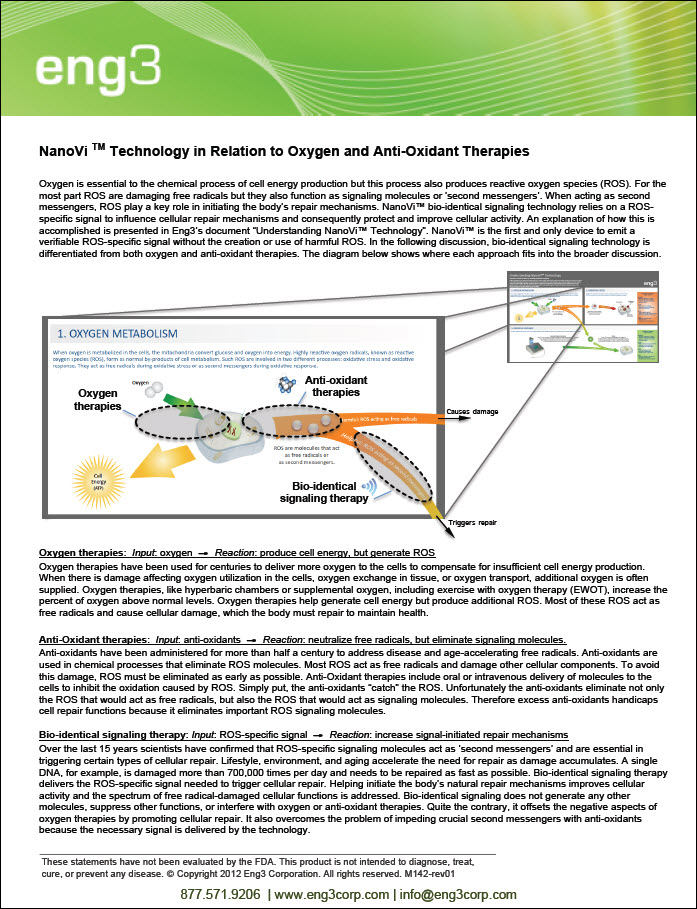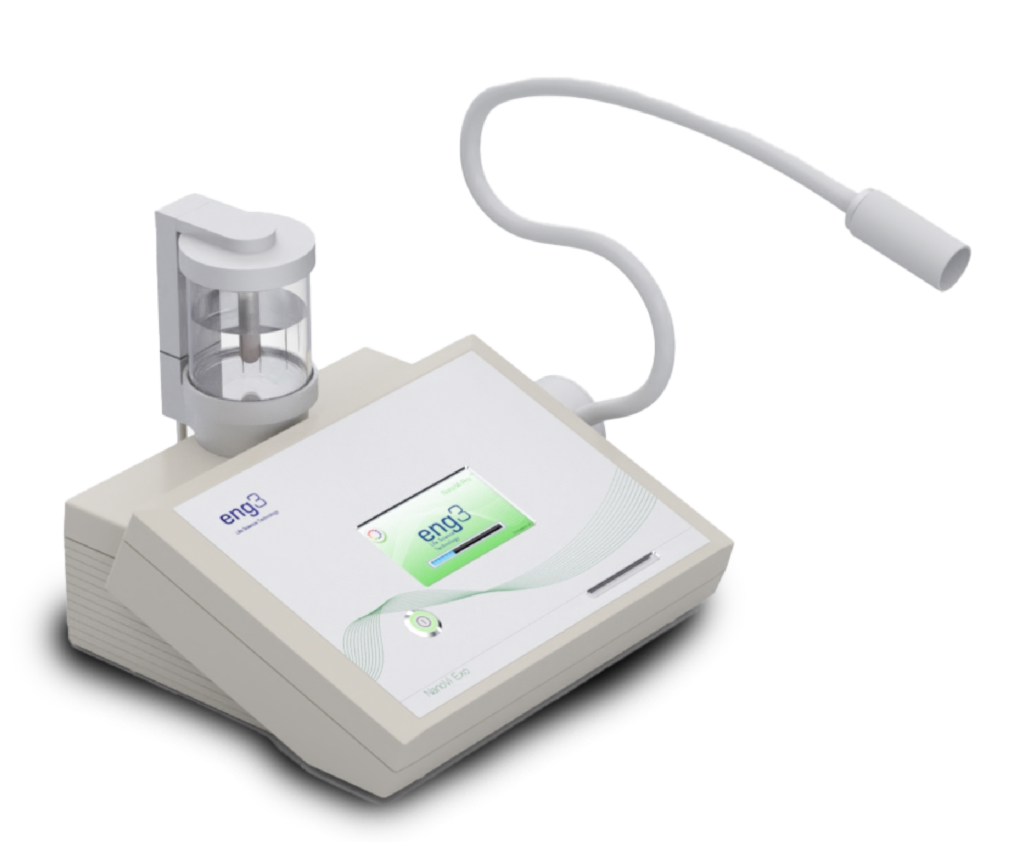NanoVi™ Technology in Relation to Oxygen and Antioxidant Therapies
Oxygen is essential to the chemical process of cell energy production but this process also produces reactive oxygen species (ROS).
For the most part ROS are damaging free radicals but they also function as signaling molecules or ‘second messengers.’
When acting as second messengers, ROS play a key role in initiating the body’s repair mechanisms. NanoVi™ bio-identical signaling technology relies on an ROS-specific signal to influence cellular repair mechanisms and consequently protect and improve cellular activity.
An explanation of how this is accomplished is presented in Eng3’s document “Understanding NanoVi™ Technology.” NanoVi™ is the first and only device to emit a verifiable ROS-specific signal without the creation or use of harmful ROS.
In the following discussion, bio-identical signaling technology is differentiated from both oxygen and anti-oxidant therapies. The diagram below shows where each approach fits into the broader discussion.
Oxygen therapies
Input: oxygen
Reaction: produce cell energy, but generate ROS
Oxygen therapies have been used for centuries to deliver more oxygen to the cells to compensate for insufficient cell energy production.
When there is damage affecting oxygen utilization in the cells, oxygen exchange in tissue, or oxygen transport, additional oxygen is often supplied. Oxygen therapies, like hyperbaric chambers or supplemental oxygen, including exercise with oxygen therapy (EWOT), increase the percent of oxygen above normal levels.
Oxygen therapies help generate cell energy but produce additional ROS. Most of these ROS act as free radicals and cause cellular damage, which the body must repair to maintain health.
Antioxidant therapies
Input: antioxidants
Reaction: neutralize free radicals, but eliminate signaling molecules
Antioxidants have been administered for more than half a century to address disease and age-accelerating free radicals. Antioxidants are used in chemical processes that eliminate ROS molecules. Most ROS act as free radicals and damage other cellular components.
To avoid this damage, ROS must be eliminated as early as possible. Antioxidant therapies include oral or intravenous delivery of molecules to the cells to inhibit the oxidation caused by ROS. Simply put, the anti-oxidants “catch” the ROS.
Unfortunately the anti-oxidants eliminate not only the ROS that would act as free radicals, but also the ROS that would act as signaling molecules. Therefore excess anti-oxidants handicaps cell repair functions because it eliminates important ROS signaling molecules. Excessive Antioxidants can be too much of a good thing but the NanoVi™ can help.
Bio-identical signaling therapy
Input: ROS-specific signal
Reaction: increase signal-initiated repair mechanisms
Over the last 15 years scientists have confirmed that ROS-specific signaling molecules act as ‘second messengers’ and are essential in triggering certain types of cellular repair. Lifestyle, environment, and aging accelerate the need for repair as damage accumulates.
A single DNA, for example, is damaged more than 700,000 times per day and needs to be repaired as fast as possible.
Bio-identical signaling therapy delivers the ROS-specific signal needed to trigger cellular repair. Helping initiate the body’s natural repair mechanisms improves cellular activity and the spectrum of free radical-damaged cellular functions is addressed. Bio-identical signaling does not generate any other molecules, suppress other functions, or interfere with oxygen or anti-oxidant therapies.
Quite the contrary, it offsets the negative aspects of oxygen therapies by promoting cellular repair. It also overcomes the problem of impeding crucial second messengers with anti-oxidants because the necessary signal is delivered by the technology.
NanoVi™ Technology in Relation to Oxygen and Antioxidant Therapies
Oxygen is essential to the chemical process of cell energy production but this process also produces reactive oxygen species (ROS).
For the most part ROS are damaging free radicals but they also function as signaling molecules or ‘second messengers.’
When acting as second messengers, ROS play a key role in initiating the body’s repair mechanisms. NanoVi™ bio-identical signaling technology relies on an ROS-specific signal to influence cellular repair mechanisms and consequently protect and improve cellular activity.
An explanation of how this is accomplished is presented in Eng3’s document “Understanding NanoVi™ Technology.” NanoVi™ is the first and only device to emit a verifiable ROS-specific signal without the creation or use of harmful ROS.
In the following discussion, bio-identical signaling technology is differentiated from both oxygen and anti-oxidant therapies. The diagram below shows where each approach fits into the broader discussion.
Oxygen therapies
Input: oxygen
Reaction: produce cell energy, but generate ROS
Oxygen therapies have been used for centuries to deliver more oxygen to the cells to compensate for insufficient cell energy production.
When there is damage affecting oxygen utilization in the cells, oxygen exchange in tissue, or oxygen transport, additional oxygen is often supplied. Oxygen therapies, like hyperbaric chambers or supplemental oxygen, including exercise with oxygen therapy (EWOT), increase the percent of oxygen above normal levels.
Oxygen therapies help generate cell energy but produce additional ROS. Most of these ROS act as free radicals and cause cellular damage, which the body must repair to maintain health.
Antioxidant therapies
Input: antioxidants
Reaction: neutralize free radicals, but eliminate signaling molecules
Antioxidants have been administered for more than half a century to address disease and age-accelerating free radicals. Antioxidants are used in chemical processes that eliminate ROS molecules. Most ROS act as free radicals and damage other cellular components.
To avoid this damage, ROS must be eliminated as early as possible. Antioxidant therapies include oral or intravenous delivery of molecules to the cells to inhibit the oxidation caused by ROS. Simply put, the anti-oxidants “catch” the ROS.
Unfortunately the anti-oxidants eliminate not only the ROS that would act as free radicals, but also the ROS that would act as signaling molecules. Therefore excess anti-oxidants handicaps cell repair functions because it eliminates important ROS signaling molecules. Excessive Antioxidants can be too much of a good thing but the NanoVi™ can help.
Bio-identical signaling therapy
Input: ROS-specific signal
Reaction: increase signal-initiated repair mechanisms
Over the last 15 years scientists have confirmed that ROS-specific signaling molecules act as ‘second messengers’ and are essential in triggering certain types of cellular repair. Lifestyle, environment, and aging accelerate the need for repair as damage accumulates.
A single DNA, for example, is damaged more than 700,000 times per day and needs to be repaired as fast as possible.
Bio-identical signaling therapy delivers the ROS-specific signal needed to trigger cellular repair. Helping initiate the body’s natural repair mechanisms improves cellular activity and the spectrum of free radical-damaged cellular functions is addressed. Bio-identical signaling does not generate any other molecules, suppress other functions, or interfere with oxygen or anti-oxidant therapies.
Quite the contrary, it offsets the negative aspects of oxygen therapies by promoting cellular repair. It also overcomes the problem of impeding crucial second messengers with anti-oxidants because the necessary signal is delivered by the technology.




